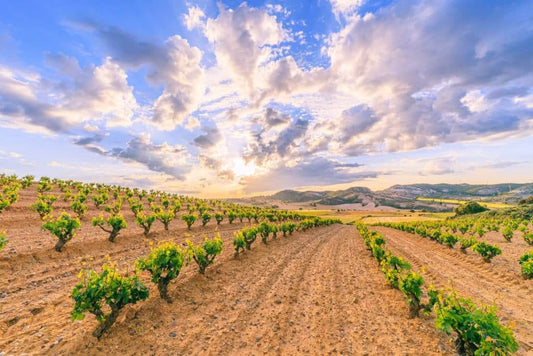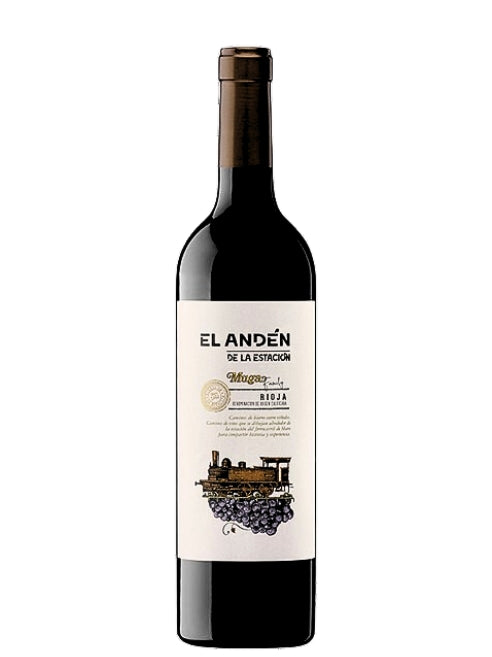Collection: Buy Spanish wines
Welcome to the Iberian Peninsula!
-
Bodegas Muga - Rioja - Crianza El Andén de la Estación 2018
Usual price 12,90€Usual priceUnit price / par -
Bodegas Muga - Rioja - Reserva 2020
Usual price 25,90€Usual priceUnit price / par -
Bodegas Muga - Rioja - Selección Especial 2019
Usual price 39,90€Usual priceUnit price / par -
Protos - Ribera del Duero - '27
(1 avis)Usual price 29,90€Usual priceUnit price / par -
Protos - Ribera del Duero - Roble 2020
(2 avis)Usual price 12,90€Usual priceUnit price / par
Discovering Spanish Wines
For several millennia, Spain has held aprominent place in the wine world. Thus, as early as 1000 BC, wines were already being produced in present-day Andalusia by the Phoenicians, and later by the Greeks. Today, the country is the third largest wine producer in the world, behind Italy and France. As you can imagine, it is therefore very difficult to succinctly summarize the entire wine-growing richness of the country of Cervantes. Nevertheless, let's make a brief summary of the key elements to remember when interested in Spanish wines.
The Spanish classification system
The first level of the Spanish hierarchy, table wines (Vino De Mesa or VDM) include wines made from grapes sourced from unclassified vineyards or made with grape varieties that sometimes do not meet the specifications of the appellations. We can compare this category to our designation Vin de France.
Then comes the category Vino de la Tierra (VDT), corresponding at the European level to a PGI (Protected Geographical Indication). A VDT wine is therefore a cuvée produced according to a well-defined specification but is less strict in terms of the use of grape varieties, terroirs, or possible yields compared to a so-called classic designation.
Spanish exception, the category Vino de Calidad con Indicación Geográfica (VCIG) was created in 2003. This mention is reserved for regions wishing to become DO (the higher category) and must undergo a transition period of at least 5 years. For the bottles concerned, you will find affixed on them the mention Vino de Calidad followed by the name of the producing region.
The higher level consists of the category DO or Denominación de Origen, corresponding to our French AOC. The wines are produced within strictly defined territories, and grape varieties, cultivation methods, as well as yields, are more restrictive.
Then, come the DOC or DOCa (Denominación de Origen Calificada), part of the elite of the Spanish wine classification. Created in 1988, this category identifies appellations whose wine quality is supposed to be superior to that of the DO. As the requirements necessary to obtain this qualification are rather complex, only two regions are currently DOCa: Rioja and Priorat.
Finally, the pyramid ends with the category Vino de Pago (VP), a designation introduced in 2003 to identify properties within DO or DOCa that have a particular microclimate and a proper name differentiating them from surrounding production areas. Among the twenty or so distinguished properties by this designation throughout Spain, stricter production conditions are also established.
The aging mentions of Spanish wines
Unlike France, Spanish legislation also defines strict criteria related to the aging of red wines, white wines and rosé wines. Here are the main details.
Joven : No minimum aging is required here. Therefore, these are generally fruity wines and smooth intended to be consumed in their youth.
Crianza : For red wines, this corresponds to a minimum total aging of 24 months, including 6 months in barrels before they can be marketed. For white and rosé wines, the total aging must be at least 18 months, including 6 months in barrels.
Reserva : For red wines, this designation corresponds to a minimum total aging of 36 months, including 12 months in barrels before they can be marketed. For white and rosé wines, the total aging must be at least 24 months, including 6 months in barrels.
Gran Reserva : For red wines, this designation corresponds to a minimum total aging of 60 months, including 18 months in barrels before they can be marketed. For white and rosé wines, the total aging must be at least 48 months, including 6 months in barrels.
Spanish appellations, grape varieties, and terroirs
Spain offers a multitude of appellations, each with its indigenous grape varieties, distinct terroirs, and unique wine styles.
The DOCa Rioja is one of the most famous appellations in Spain. Located in the north of the country, it is renowned for its powerful and elegant red wines, generally endowed with a very good aging potential. The star of the vineyard here is the Tempranillo grape variety (78% of the plantations), sometimes accompanied by Mazuelo (Carignan), Graciano, or Garnacha (Grenache). For white wines, the grape varieties Viura, Malvasía and White Grenache are predominant. To introduce yourself to the wines of the region, feel free to take a close interest in the cuvées or the famous Bodegas Muga !
The appellation is divided into three zones : Rioja Alavesa, Rioja Alta, and Rioja Baja. The vineyards of the first two sub-regions are located at an altitude between 500m and 800m and have a climate with oceanic influences (coolness and humidity). On the other hand, Rioja Baja is drier and Mediterranean. Finally, the soils of the region are predominantly clay-limestone.
The DO Ribera del Duero is another star wine region of Spain. The climate here is continental with hot, dry summers and very cold winters. The wines produced are almost exclusively reds, although the production of rosés is also possible. Once again, the Tempranillo grape variety is the most prevalent, producing powerful wines, tannic, warm, and with good aging potential. Other grape varieties like Cabernet Sauvignon, Malbec and Merlot are also authorized but rarely used. Here too, the terroir is mainly clay-limestone. The Bodegas Protos, an illustrious estate in the region, are an excellent way to discover the possibilities that the great local wines offer.
Of course, many other appellations also exist such as Rias Baixas, and its Albariño, Rueda, Bierzo and its famous Mencía grape variety, the DO Toro, Priorat and Penedès in Catalonia, Jumilla and Yecla with a hot and arid climate perfectly suited to Monastrell (Mourvèdre) a fascinating wine country, offering a millennia-old wine history as well as a wide range of appellations and wines.
From the world-renowned Rioja to the powerful red wines of Ribera del Duero, and the lively and aromatic white wines of Rueda or Rías Baixas, each wine region has its own charm and distinct character. So set out to discover them! And if you need advice, do not hesitate to call on La Cave Éclairée !
-

Discovering the Wines of Rioja
Just like France, Spain is a country whose history and culture are closely linked to viticulture. Among the many Spanish wine regions, Rioja holds a prominent place. Nestled in the...
Discovering the Wines of Rioja
Just like France, Spain is a country whose history and culture are closely linked to viticulture. Among the many Spanish wine regions, Rioja holds a prominent place. Nestled in the...
-

All about the wines of Ribera del Duero
The Ribera del Duero is a name that resonates with all lovers of Spanish wines. The appellation is indeed one of the most renowned in the entire country and impresses...
All about the wines of Ribera del Duero
The Ribera del Duero is a name that resonates with all lovers of Spanish wines. The appellation is indeed one of the most renowned in the entire country and impresses...
-

All about the Tempranillo grape variety
Have you ever tasted a warm red wine made from the Tempranillo grape variety? If not, you are about to discover one of the most iconic varieties in the wine...
All about the Tempranillo grape variety
Have you ever tasted a warm red wine made from the Tempranillo grape variety? If not, you are about to discover one of the most iconic varieties in the wine...
-

Portrait of the Cabernet Sauvignon grape variety
The Cabernet Sauvignon is most likely, along with Chardonnay, the most well-known grape variety among wine enthusiasts. And for good reason, with 341,000 hectares, it is simply the most planted wine grape...
Portrait of the Cabernet Sauvignon grape variety
The Cabernet Sauvignon is most likely, along with Chardonnay, the most well-known grape variety among wine enthusiasts. And for good reason, with 341,000 hectares, it is simply the most planted wine grape...
-
✔️ 100% OF THE WINES TASTED
-
📦 FAST AND SECURE SHIPMENTS
-
🍷 IDEAL CONSERVATION
-
💳 100% SECURE PAYMENTS









